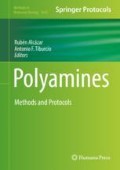Abstract
It is thought that the major factor responsible for cell damage is reactive oxygen species (ROS), but our recent studies have shown that acrolein (CH2=CH-CHO) produced from spermine and spermidine is more toxic than ROS. Thus, (1) the mechanism of acrolein production during brain stroke, (2) one of the mechanisms of acrolein toxicity, and (3) the role of glutathione in acrolein detoxification are described in this chapter.
References
Igarashi K, Kashiwagi K (2010) Modulation of cellular function by polyamines. Int J Biochem Cell Biol 42:39–51
Saiki R, Nishimura K, Ishii I, Omura T, Okuyama S, Kashiwagi K, Igarashi K (2009) Intense correlation between brain infarction and protein-conjugated acrolein. Stroke 40:3356–3361
Saiki R, Park H, Ishii I, Yoshida M, Nishimura K, Toida T, Tatsukawa H, Kojima S, Ikeguchi Y, Pegg AE, Kashiwagi K, Igarashi K (2011) Brain infarction correlates more closely with acrolein than with reactive oxygen species. Biochem Biophys Res Commun 404:1044–1049
Sharmin S, Sakata K, Kashiwagi K, Ueda S, Iwasaki S, Shirahata A, Igarashi K (2001) Polyamine cytotoxicity in the presence of bovine serum amine oxidase. Biochem Biophys Res Commun 282:228–235
Tabor CW, Tabor H, Bachrach U (1964) Identification of the aminoaldehydes produced by the oxidation of spermine and spermidine with purified plasma amine oxidase. J Biol Chem 239:2194–2203
Bachrach U (1970) Oxidized polyamines. Annu N Y Acad Sci 171:939–956
Watanabe S, Kusama-Eguchi K, Kobayashi H, Igarashi K (1991) Estimation of polyamine binding to macromolecules and ATP in bovine lymphocytes and rat liver. J Biol Chem 266:20803–20809
Nakamura M, Uemura T, Saiki R, Sakamoto A, Park H, Nishimura K, Terui Y, Toida T, Kashiwagi K, Igarashi K (2016) Toxic acrolein production due to Ca2+ influx by the NMDA receptor during stroke. Atherosclerosis 244:131–137
Nakamura M, Tomitori H, Suzuki T, Sakamoto A, Terui Y, Saiki R, Dohmae N, Igarashi K, Kashiwagi K (2013) Inactivation of GAPDH as one mechanism of acrolein toxicity. Biochem Biophys Res Commun 430:1265–1271
Tomitori H, Nakamura M, Sakamoto A, Terui Y, Yoshida M, Igarashi K, Kashiwagi K (2012) Augmented glutathione synthesis decreases acrolein toxicity. Biochem Biophys Res Commun 418:110–115
Tanaka Y, Marumo T, Omura T, Yoshida S (2007) Quantitative assessments of cerebral vascular damage with a silicon rubber casting method in photochemically-induced thrombotic stroke rat models. Life Sci 81:1381–1388
Ayusawa D, Iwata K, Seno T (1981) Alteration of ribonucleotide reductase in aphidicolin-resistant mutants of mouse FM3A cells with associated resistance to arabinosyladenine and arabinosylcytosine. Somatic Cell Genet 7:27–42
Laemmli UK (1970) Cleavage of structural proteins during the assembly of the head of bacteriophage T4. Nature 227:680–685
Nielsen PJ, Manchester KL, Towbin H, Gordon J, Thomas G (1982) The phosphorylation of ribosomal protein S6 in rat tissues following cycloheximide injection, in diabetes, and after denervation of diaphragm. A simple immunological determination of the extent of S6 phosphorylation on protein blots. J Biol Chem 257:12316–12321
Pelham HR, Jackson RJ (1976) An efficient mRNA-dependent translation system from reticulocyte lysates. Eur J Biochem 67:247–256
Rappaport ZH, Young W, Flamm ES (1987) Regional brain calcium changes in the rat middle cerebral artery occlusion model of ischemia. Stroke 18:760–764
Grynkiewicz G, Poenie M, Tsien RY (1985) A new generation of Ca2+ indicators with greatly improved fluorescence properties. J Biol Chem 260:3440–3450
Igarashi K, Shirahata A, Pahk AJ, Kashiwagi K, Williams K (1997) Benzyl-polyamines: novel, potent N-methyl-d-aspartate receptor antagonists. J Pharmacol Exp Ther 283:533–540
Uemura T, Nakamura M, Sakamoto A, Suzuki T, Dohmae N, Terui Y, Tomitori H, Casero RA Jr, Kashiwagi K, Igarashi K (2016) Decrease in acrolein toxicity based on the decline of polyamine oxidases. Int J Biochem Cell Biol 79:151–157
Acknowledgments
We are grateful to Dr. A.J. Michael for critical reading of the manuscript prior to submission.
Author information
Authors and Affiliations
Corresponding author
Editor information
Editors and Affiliations
Rights and permissions
Copyright information
© 2018 Springer Science+Business Media LLC
About this protocol
Cite this protocol
Igarashi, K., Uemura, T., Kashiwagi, K. (2018). Acrolein: An Effective Biomarker for Tissue Damage Produced from Polyamines. In: Alcázar, R., Tiburcio, A. (eds) Polyamines. Methods in Molecular Biology, vol 1694. Humana Press, New York, NY. https://doi.org/10.1007/978-1-4939-7398-9_38
Download citation
DOI: https://doi.org/10.1007/978-1-4939-7398-9_38
Published:
Publisher Name: Humana Press, New York, NY
Print ISBN: 978-1-4939-7397-2
Online ISBN: 978-1-4939-7398-9
eBook Packages: Springer Protocols

